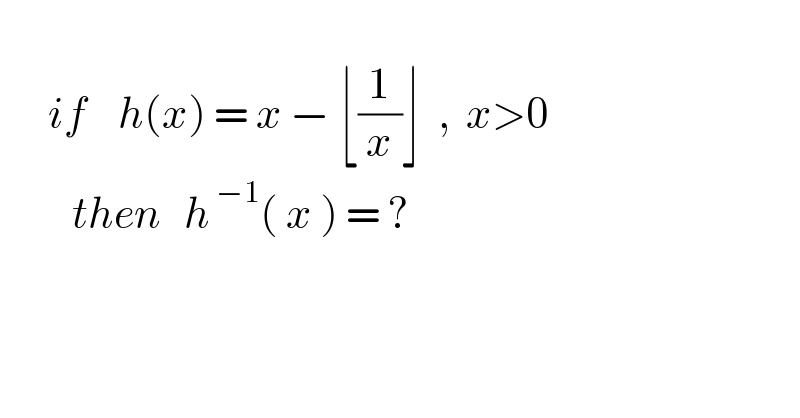
Question and Answers Forum
Question Number 164826 by mnjuly1970 last updated on 22/Jan/22

Answered by TheSupreme last updated on 22/Jan/22

Answered by mahdipoor last updated on 23/Jan/22
![1) x>1 ⇒ y>1 ⇒0<(1/x)<1 ⇒y=x−[(1/x)]=x ⇒h^(−1) (x)=x 2) x=1 ⇒ y=0 ⇒h^(−1) (0)=1 3) 0<x<1 ⇒ y<0 y=x−[(1/x)] ⇒ {y}={x−[(1/x)]} ={x}=x ⇒ h^(−1) (x)=x 1,2,3⇒h^(−1) (x)= { ((x x>1)),((1 x=0 )),(({x} x<0)) :}](Q164894.png)
| ||
Question and Answers Forum | ||
Question Number 164826 by mnjuly1970 last updated on 22/Jan/22 | ||
 | ||
Answered by TheSupreme last updated on 22/Jan/22 | ||
 | ||
| ||
Answered by mahdipoor last updated on 23/Jan/22 | ||
![1) x>1 ⇒ y>1 ⇒0<(1/x)<1 ⇒y=x−[(1/x)]=x ⇒h^(−1) (x)=x 2) x=1 ⇒ y=0 ⇒h^(−1) (0)=1 3) 0<x<1 ⇒ y<0 y=x−[(1/x)] ⇒ {y}={x−[(1/x)]} ={x}=x ⇒ h^(−1) (x)=x 1,2,3⇒h^(−1) (x)= { ((x x>1)),((1 x=0 )),(({x} x<0)) :}](Q164894.png) | ||
| ||